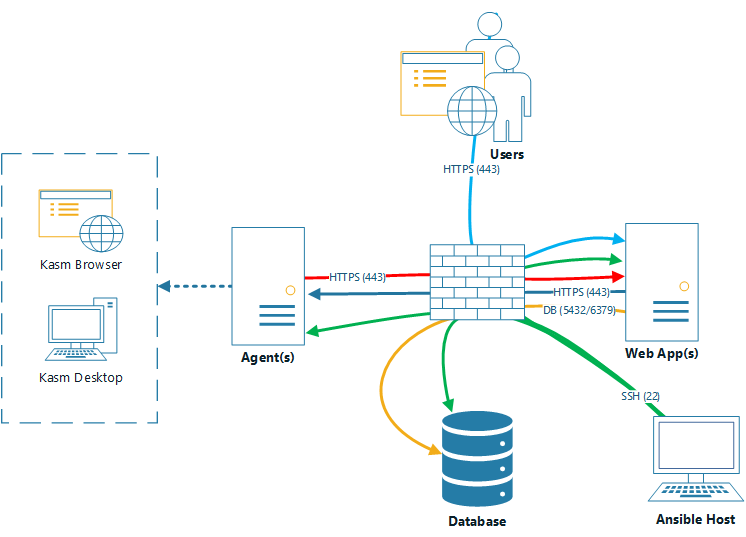KASM-1918 Ensure that the uninstall playbook removes stopped kasm containers Closes KASM-1918 See merge request kasm-technologies/internal/ansible!7 |
||
|---|---|---|
| group_vars | ||
| roles | ||
| .gitignore | ||
| backup_db.yml | ||
| install_kasm.yml | ||
| inventory | ||
| README.md | ||
| restart_kasm.yml | ||
| start_kasm.yml | ||
| stop_kasm.yml | ||
| uninstall_kasm.yml | ||
Ansible
Installing Ansible
This project requires ansible 2.9.24 or greater on the host running the ansible playbook. The target systems do no not need Ansible installed.
The steps below for installing Ansible have been tested on CentOS 7.9.2009, CentOS 8.4.2105, Debian 9.13, Debian 10.10, Ubuntu 18.04.5, and Ubuntu 20.04.3.
-
Ensure pip3 is installed
Ubuntu/Debian:
sudo apt install python3-pipCentOS:
sudo yum install python3-pip -
Add local bin directory to path in bashrc
echo 'PATH=$PATH:$HOME/.local/bin' >> ~/.bashrc source ~/.bashrc -
Use pip to install ansible
python3 -m pip install --user -U pip && python3 -m pip install --user -U ansible -
Ensure that ansible version is greater than 2.9.24
ansible --version
Kasm Multi Server install
This playbook will deploy Kasm Workspaces in a multi-server deployment using Ansible.
- It installs the kasm components on the systems specified in the ansible
inventoryrequired for the respective roles (db, web, agent). - It creates a new swapfile to ensure that the total swap space matches the size
desired_swap_sizespecified on the files in group_vars/. - It enables the docker daemon to run at boot to ensure that kasm services are started after a reboot.
It has been tested on CentOS 7.9.2009, CentOS 8.4.2105, Debian 9.13, Debian 10.10, Ubuntu 18.04.5, and Ubuntu 20.04.3
Ansible Configuration
-
Open
roles/install_common/vars/main.yml,group_vars/agent.ymland update variables if desired. -
Open
inventoryfile and fill in the hostnames / ips for the servers that will be fulfilling the agent, webapp and db roles. -
Run the deployment.
ansible-playbook -Kk -u [username] -i inventory install_kasm.ymlAnsible will prompt you for the ssh password and sudo password (will almost always be the same password).
Or, if you have ssh keys copied over to your servers and have NOPASSWD in sudoers you can just run.
ansible-playbook -u [username] -i inventory install_kasm.yml -
Login to the deployment as admin@kasm.local using the IP of one of the WebApp servers (eg https://192.168.1.2)
-
Navigate to the Agents tab, and enable each Agent after it checks in. (May take a few minutes)
Kasm Uninstall playbook
This playbook uninstalls Kasm workspaces from DB, WebApp and Agent servers specified in the inventory file.
It has been tested on CentOS 7.9.2009, CentOS 8.4.2105, Debian 9.13, Debian 10.10, Ubuntu 18.04.5, and Ubuntu 20.04.3
Ansible Configuration
-
Open
inventoryfile and fill in the hostnames / ips for the servers that will be fulfilling the agent, webapp and db roles. -
Run the deployment.
ansible-playbook -Kk -u [username] -i inventory uninstall_kasm.ymlAnsible will prompt you for the ssh password and sudo password (will almost always be the same password).
Or, if you have ssh keys copied over to your servers and have NOPASSWD in sudoers you can just run.
ansible-playbook -u [username] -i inventory uninstall_kasm.yml
Kasm Stop/Start/Restart playbooks
These playbooks can be used to start, stop or restart Kasm workspaces services on the DB, WebApp and Agent servers specified in the inventory file.
It can be limited to run only on hosts in specific groups by passing -l [db, web, or agent] flag.
In the examples restart_kasm.yml can be substituted for start_kasm.yml or stop_kasm.yml for starting or stopping the kasm services respectively.
Ansible Configuration
-
Open
inventoryfile and fill in the hostnames / ips for the servers that will be fulfilling the agent, webapp and db roles. -
Run the playbook.
ansible-playbook -Kk -u [username] -i inventory restart_kasm.ymlAnsible will prompt you for the ssh password and sudo password (will almost always be the same password).
Or, if you have ssh keys copied over to your servers and have NOPASSWD in sudoers you can just run.
ansible-playbook -u [username] -i inventory restart_kasm.ymlIf you only want to run it against hosts in the 'db' group for example you can run the following:
ansible-playbook -u [username] -l db -i inventory restart_kasm.yml
Kasm Database Backup playbook
This playbook can be used to backup the Kasm Workspaces database to a location on the Database server specified by remote_backup_dir and optionally to a location on the ansible server specified by local_backup_dir. Backups older than retention_days are automatically cleaned up.
Ansible Configuration
-
Open
roles/backup_db/vars/main.ymland update variables if desired. -
Open
inventoryfile and fill in the hostnames / ips for the servers that will be fulfilling the agent, webapp and db roles. -
Run the playbook.
ansible-playbook -Kk -u [username] -i inventory backup_db.ymlAnsible will prompt you for the ssh password and sudo password (will almost always be the same password).
Or, if you have ssh keys copied over to your servers and have NOPASSWD in sudoers you can just run.
ansible-playbook -u [username] -i inventory backup_db.yml
